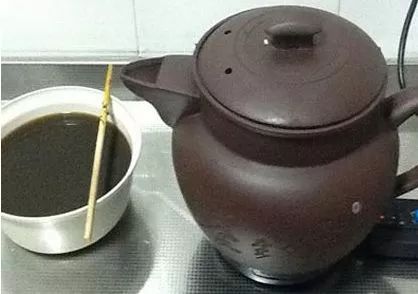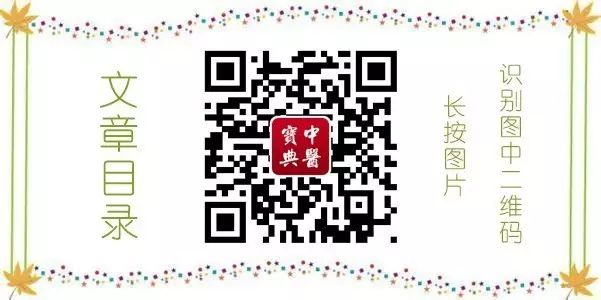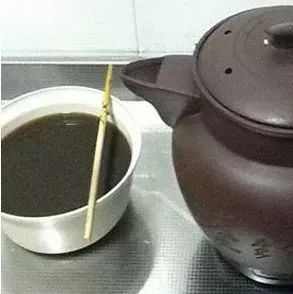
【Traditional Chinese Medicine App】Online/Offline Reading of Ancient and Modern TCM Books >>>

Discussion on Decoction Powders
Decoction powders refer to the process of grinding Chinese medicinal herbs into coarse powder and boiling them in water for consumption. Currently, discussing its origins and principles holds significant meaning.
The practice of decoction powders dates back to ancient times, as seen in the “Shang Han Za Bing Lun” (Treatise on Cold Damage and Miscellaneous Diseases) with the formula Ma Xing Yi Gan Tang (Ephedra, Apricot Kernel, Coix Seed Decoction), which is a form of decoction powder. However, in ancient formulations, it was relatively rare. The term “decoction powder” became a specialized term, seemingly in the Tang Dynasty. According to statistics, in the “Wai Tai Mi Yao” (Secret Essentials from the Outer Chamber), there are about twenty formulas explicitly labeled as decoction powders, while those that actually used the decoction powder method were still referred to as “tang” (decoctions) and were not listed.
During the Song Dynasty, the officially promulgated standard formula manual “Tai Ping Hui Min He Ji Ju Fang” (Formulas for Benefiting the People) saw a significant increase in decoction powder formulas. It is reported that this book contains a total of 788 prescriptions, of which decoction powder formulas account for 237 (including different types of decoction powders), indicating that by that time, “decoction powder” had become one of the mainstream dosage forms.
In the Northern Song Dynasty, Shen Cunzhong (Note 1) mentioned in his work “Mengxi Bitan” (Dream Stream Conversations) that decoction powders were listed as the fifth category of “Yao Yi” (Pharmaceutical Discussions), and he also included this in his work “Liang Fang” (Good Formulas). The original text states: “Tang (decoctions), wan (pills), and san (powders) each have their appropriate uses; ancient formulas predominantly used tang, while wan and san were rarely used.” He further discussed the differences in the use of tang, wan, and san, highlighting that the method of using decoction powders differs from that of swallowing powders. He then stated: “In recent times, the use of tang has decreased; those who require tang should use decoction powders entirely,” and added, “For decoction powders, the maximum amount is only about three to five qian (a traditional weight unit).” Shen’s remarks reflect the actual situation of that time and are consistent with the facts.
The promotion of decoction powders has historical significance and practical relevance. The main point is to conserve medicinal resources without diminishing their efficacy. In other words, it is about making full use of medicinal materials to avoid unnecessary waste.
Furthermore, institutions like the Hui Min He Ji Ju (Beneficial Medicine Bureau) primarily sold standardized medicinal products and sometimes distributed medicines to war zones and disaster areas (Note 2). Therefore, in addition to pills, powders, and ointments, they also included fixed formulations of coarse powders for decoction powders to replace liquid decoctions. The advantages of decoction powders in this regard are:
They occupy less volume (much smaller than raw medicinal materials), are easy to carry (unlike pills and ointments that cannot withstand pressure), are easy to store (unlike honey pills and ointments that are prone to mold), require fewer steps in the preparation process (just coarsely grinding is sufficient), and are quick and convenient to boil (in conditions where boiling is not possible, even soaking in hot water works), conserving medicinal materials (about one-third to one-fourth the amount of a decoction).
Based on these characteristics, the proportion of decoction powder formulas in the “He Ji Ju Fang” significantly increased and almost became mainstream, which is why Shen Cunzhong stated that “recently, the use of tang has decreased; those who require tang should use decoction powders entirely.”
At that time, the emphasis on conserving medicinal resources can be reflected in the work “Shang Han Zong Bing Lun” (Comprehensive Treatise on Cold Damage) by Pang Anshi, who lived around the same time as Shen.
In Volume Six of “Shang Han Zong Bing Lun,” there is a section on “Distinctions” and a letter titled “Discussion on Cold Damage” that discusses decoction powders. Moreover, in the appendix “Revising Medicinal Methods,” there is a statement from Pang’s disciple Wei Bing, mainly discussing decoction powders. Pang clearly states the reasons for changing decoctions to decoction powders, saying: “Since the Tang Dynasty, due to the An-Shi Rebellion, the local warlords were rampant, and during the Five Dynasties, the country was in turmoil, making transportation difficult. Therefore, physicians conserved by using decoctions as decoction powders.” In the letter, he elaborates on the reasons, stating: “Thus, physicians used fewer decoctions and more decoction powders.” Although Pang only mentioned the Tang Dynasty, he avoided discussing the Song Dynasty. In reality, during the Northern Song Dynasty, the northern regions of China experienced frequent changes in power, and transportation in the north and northwest was often obstructed, with some medicinal materials even requiring barter for exchange. Therefore, the supply was insufficient, necessitating conservation efforts.
Decoction powders not only conserve medicinal resources but also address some practical difficulties. Under the research and advocacy of medical scholars during the Song, Jin, and Yuan Dynasties, they experienced significant development and almost became the primary dosage form. For instance, in the “He Ji Ju Fang,” some important formulas adopted the decoction powder method, such as Ren Shen Bai Du San (Ginseng Powder for Overcoming Pathogenic Factors), Liang Ge San (Cooling the Diaphragm Powder), Ba Zheng San (Eight Rectifications Powder), and Dao Chi San (Guide Out Red Powder), which involve grinding the medicinal materials into coarse powder and boiling them to remove the dregs for consumption, with a typical dosage of two to three qian. There are also formulas that are ground into fine powder and consumed with the dregs after boiling, such as Huo Xiang Zheng Qi San (Agastache Powder for Correcting Qi) and Ping Wei San (Stomach Harmonizing Powder), with each dose also being two qian.
Some formulas, despite being named “tang” or “yin” (drinks), still follow the decoction powder method in practice, such as Sheng Ma Ge Gen Tang (Cimicifuga and Kudzu Decoction), Liu He Tang (Six Harmonies Decoction), Su Zi Jiang Qi Tang (Perilla Seed Decoction for Regulating Qi), Er Chen Tang (Two Aged Decoction), Si Qi Tang (Four Seven Decoction), Gan Lu Yin (Sweet Dew Drink), and Qing Liang Yin Zi (Cooling Drink), with a single dose of two qian, and the maximum amount being no more than four qian.
By the Ming and Qing Dynasties, the dosage form of decoction powders gradually decreased. If we use Pang Anshi’s argument to evaluate this, it may be due to a relatively stable domestic situation over a long period, leading to an abundance of medicinal sources, thus favoring the use of decoction pieces. Decoction pieces are visually appealing and less prone to errors, which are their advantages, and therefore decoction powders were no longer strongly advocated by physicians.
However, during the preparation process, soaking can lead to a loss of medicinal content. Therefore, in works such as “Lan Tai Gui Fan” and “Wen Bing Tiao Bian,” many formulas still adopt the decoction powder method, such as the first famous formula in “Wen Bing Tiao Bian”—Yin Qiao San (Silver Flower Powder), which is indeed a decoction powder. Up until the founding of New China, in my hometown of Yangzhou, many pharmacies stocked Yin Qiao San, Jia Jian Pu Ji Xiao Du San (Modified Universal Detoxifying Powder), and Su Bi San (Nasal Powder), which became commonly used medicines for the prevention and treatment of upper respiratory infections, pharyngitis, tonsillitis, parotitis, rhinitis, and sinusitis. Many patients would often self-purchase these medicines, solving numerous issues.
In addition, I personally noticed that using a typical decoction (weighing about two liang) reduced to one-third of its weight, ground into coarse powder for decoction, and after removing the dregs, the viscosity is much thicker than that of a whole decoction. I have observed that when boiling soup over coal fire, if the heat is too intense, it often results in a clear broth, and upon examining the medicinal materials, the center of the coix seed and gorgon fruit remains dry, the lotus flesh has not softened, and the outer skin of the cassia seed and black bean is only slightly moistened, with most remaining intact. Some Poria, cut into cubes like dice, after boiling, only the outer skin is moistened, while the center remains dry. I have also tasted the boiled Astragalus and jujube, which still retain their sweetness.
Decoction powders, due to their smaller unit area, increase the contact area with water during boiling, making it easier for the effective components of the medicine to dissolve. Although the dosage is smaller, it can enhance the utilization rate of the medicine, achieving effects comparable to decoction pieces.
Some research institutions and clinical units have conducted substantial practical research, yielding convincing results, such as:
1. The Institute of Traditional Chinese Medicine Research selected different prescriptions to compare the effective content of decoction pieces and coarse powder decoction methods. They measured two prescriptions: Da Huang Huang Lian Xie Xin Tang (Rhubarb and Coptis Decoction) to determine the anthraquinone content from rhubarb, and Si Ni Tang (Frigid Extremities Decoction) to measure the aconitine content from Fu Zi (Aconite). They used the original prescription dosage for decoction pieces and the coarse powder prescription was identical to the decoction, but with two-thirds of the amount reduced. The soaking time, boiling time, heating, and containers were all identical (Note 5). The results showed that “the coarse powder reduced the dosage, but the quality of the decoction did not significantly decrease. The application of coarse powder decoction (decoction powder) not only reduces waste and conserves medicinal materials but also does not differ much from ordinary decoctions.”
2. The same institution conducted in-depth experimental research using prescriptions such as Xie Xin Tang, Si Ni Tang, Si Wu Tang (Four Substances Decoction), Qin Shao Tang (Scutellaria and Paeonia Decoction), and Gui Pi Tang (Restore the Spleen Decoction), concluding that the extraction amounts of the contained components were increased, “indicating that the coarse powder at 1/3 dosage had a higher extraction rate than the full amount, possibly due to the reduced dosage leading to a relative increase in concentration. However, whether using the full amount of coarse powder or 1/3 amount, it shows that it can conserve medicinal materials. Initially, it seems advisable to take 1/3 to 1/2 of the decoction piece prescription amount.”
3. Some research units have studied the effects of coarse powder decoction and fine powder infusion, believing it can enhance efficacy and utilization rates (Note 7).
4. Some places compared the decoction liquid of single-flavor licorice pieces and coarse powder, finding that the decoction liquid from coarse powder had higher physical constants and glycyrrhizin extraction amounts than the decoction pieces (Note 8).
5. Some places conducted a comparative study on the extraction rates of medicinal materials of different sizes, which can be referenced (Note 9).
There are many related materials, and the above five examples are sufficient to illustrate the issue. They demonstrate that the decoction powder method used by Shen Cunzhong, Pang Anshi, and in the “He Ji Ju Fang” does not diminish medicinal efficacy and can conserve some medicinal materials.
Today, our social system, production conditions, living conditions, and health levels are entirely different from those of their time. In the past, the vast majority of people could not receive timely treatment for illnesses, and medicinal materials were used not only for treating diseases but also for preventing them. Therefore, the required quantities are many times greater than before, and some medicines naturally have low yields, making conservation and rational use still necessary. Chairman Mao taught us to “practice frugality” and emphasized that “everywhere must cherish human and material resources, and never focus only on the moment, wasting recklessly.” Decoction powders can conserve some medicinal materials while ensuring quality and quantity, making them worthy of review and research.
In 1965, I participated in a medical team in a certain commune in the suburbs of Beijing, where I did some work in this area. Coincidentally, we were stationed at a commune health center, which had a simple Chinese medicine pharmacy. Although the medicinal sources were not abundant, the variety was acceptable, and there was a set of traditional pharmaceutical tools.
Initially, I prescribed according to the principles of syndrome differentiation and treatment. However, I only used one-third of the dosage, personally selecting the herbs and dividing them into several groups: one group for grinding, which I ground into appropriate coarse powder; another group that was difficult to grind, such as Tian Dong (Asparagus), and Shu Di (Rehmannia), which I cut with a knife; a group that could not be cut with a knife, such as Zhu Ru (Bamboo Shavings), Si Gua Luo (Luffa), and Da Fu Pi (Trichosanthes), which I cut with scissors; and another group that ground into fine powder, which was not suitable, such as Hua Rui Shi (Flower Bud Stone), Zi Shi Ying (Purple Quartz), and Mu Li (Oyster), which I crushed with a copper pestle (the above are examples and not all found in one prescription). After processing, I combined them into one, divided them into several portions, and instructed the patients to use one portion each time, boiling it twice and filtering it for consumption. The price was low, and the effect was good, which was well received by the patients.
Later, after a general survey, combining the local incidence and living habits, I derived some commonalities from the specifics. To avoid confusion during emergencies, I collaborated with team members and local physicians to study and determine several formulas based on ancient prescriptions, collective experiences, and current needs, known as agreed prescriptions. These were prepared and packaged, and when necessary, I would add one or two herbs based on syndrome differentiation and treatment for patients with relatively stable and uncomplicated conditions.
This way, obtaining medicine was quick, and using it was convenient, with satisfactory effects. Although the dosage form was modified and the content was correspondingly reduced, the theoretical basis remained unchanged, and the effects were not affected, standing firm. At the same time, the rationale was clearly explained, and in a short time, the local trend of “preferring large formulas and expensive medicines” was shifted. Patients became increasingly interested, with some even specifically requesting the coarse powders made by the doctor.
Of course, the implementation of a practice cannot be smooth sailing. Although this was a partial reform, I still heard some rumors from nearby individuals claiming to be knowledgeable about medicine (Note 10).
At that time, our approach was flexible and adaptable. We did not abandon everything just because we used decoction powders, nor did we discard all other methods because we used agreed prescriptions. The principle was to use what was appropriate. If a single prescription was needed for decoction pieces or coarse powders, we would still follow through. This way, there were three forms:
One was specially prepared decoctions from decoction pieces, the second was custom coarse powder decoctions, and the third was agreed prescriptions for decoction powders, primarily based on the condition, and not a rigid application. Whether decoction powders or agreed prescriptions, they were still used under the premise of syndrome differentiation and treatment, without deviating from the principles of theory, formulas, and medicines, remaining within traditional practices, and should not be viewed in opposition.
Promoting decoction powders does not mean completely replacing decoctions made from decoction pieces; they each have their advantages and should be adapted to local conditions, diseases, and individuals. The “Shang Han Zong Bing Lun” also clearly states that certain prescriptions are not suitable for decoction powders. Shen Cunzhong also mentioned that “the application depends entirely on the skill of the practitioner; it cannot be rigidly defined.”
In some places, promoting decoction powders involves pre-preparing each medicinal herb into coarse powder for temporary use, which is also a convenient method. However, it must be labeled clearly to avoid confusion; if it is ambiguous, it could lead to mistakes. Therefore, careful verification must be emphasized, considering “verification” as an important part of the decoction powder process, which I elaborate on here.
Decoction powders also have the advantage of possessing disinfecting properties, as pills and swallowed powders are often not heated and may contain insect eggs, etc.
Now, I will quote two passages (Note 5) from the papers to conclude.
“The dosage of decoction powders is less than that of decoctions, yet the application methods and properties of the dosage forms are the same as those of decoctions, so in clinical applications, they can achieve effects basically consistent with decoctions, still fully utilizing the characteristics of decoction prescriptions, syndrome differentiation, and treatment, and adjustments according to symptoms.”
“Using coarse powder for decoction aligns with TCM theory and traditional medication habits, while also having certain scientific basis.”
This article has been reviewed by Liu Shoushan, and I express my gratitude here.
(Note 1) Shen Cunzhong (1031–1095), also known as Kua, was a well-known figure in the Northern Song Dynasty who was both a politician and a physician. He authored “Mengxi Bitan” in twenty-six volumes, with the last volume being “Yao Yi” (Pharmaceutical Discussions), and he added several related notes in “Bu Bi”. He also wrote “Liang Fang” and “Ling Yuan Fang,” the latter of which has been lost, while the former still exists in mixed editions.
(Note 2) For details, see “Song Hui Yao Ji Gao”; there is a wealth of related information, covering events from the Xining, Yuanfeng, Shaosheng, Chongning, Xuanzong, Shaoxing, Longxing, Qiandao, and Chunxi periods, including the distribution of summer medicines, pestilential medicines, as well as disasters, wars, and diseases. The articles are not fully quoted.
(Note 3) Referring to the “Wen Bing Tiao Bian” treatment of warm toxins, the modified Pu Ji Xiao Du San does not use Chai Hu (Bupleurum) and instead adds Jin Yin Hua (Honeysuckle).
(Note 4) Based on Yu Tuan’s “Medical Truth”, using the root of Si Gua (Luffa) ground into powder is very effective for treating nasal diseases.
(Note 5) The original text can be found in the “Chinese Medicine Journal” 1961, Issue 4, titled “Preliminary Introduction to the Decoction of Powdered Chinese Medicine,” with detailed methods not fully quoted.
(Note 6) The original text can be found in the “Chinese Medicine Journal” 1962, Issue 5, titled “Experimental Research on Decoction of Coarse Powdered Chinese Medicine,” authored by Meng Guangrong, Chen Mei, and Lin Yuhua, with content not fully quoted.
(Note 7) The original text can be found in “Guangdong Traditional Chinese Medicine” November 1960, titled “Inheriting the Experience of Traditional Chinese Medicine Dosage Forms, Experimental Introduction to Improving Efficacy and Utilization Rates of Coarse Powder Decoction and Fine Powder Infusion.” Unit: Guangdong Provincial Institute of Traditional Chinese Medicine.
(Note 8) The original text can be found in “Jiangxi Medicine” 1965, Volume 5, Issue 2, titled “Comparison of Effective Components Extracted from Licorice Decoction Pieces and Coarse Powder,” authored by Liu Zhongyu.
(Note 9) The original text can be found in “Harbin Traditional Chinese Medicine” 1964, Volume 7, Issue 5, authored by Shi Jiuliang, Shen Yinghuan, and Tong Wanjun.
(Note 10) For example, saying that decoction pieces are better, coarse powders are unreliable, that one cannot cure diseases without spending three to five yuan, that physicians who do not know how to use ginseng, deer antler, antelope horn, and rhinoceros horn are not considered skilled, and that one cannot create good formulas without using twenty or thirty herbs. Overall, these are all promoting large formulas and expensive medicines. I have also heard the saying, “Medicine fills the intestines,” which implies that one must boil the medicine into several large bowls, causing the patient to feel bloated, which is considered authentic, etc.
This article is excerpted from “Shaanxi New Medicine”
Author / Geng Jianting
The above content is for reference only.

《The TCM Stories of Grandfather and Grandson》 is understandable to everyone ★★★★★
-
“Three-Year Mugwort,” what value does mugwort have? ★★
-
The miraculous effects of Coix Seed ★★
-
Do not underestimate “Sesame and Mung Beans”
-
As the weather cools, enjoy a bowl of nourishing porridge to warm your stomach
-
The famous fruit of the Nine Provinces—Pomegranate
-
Simple understanding of the Pinching Spine Method~ ★★★
-
Summary and sharing of the rules of the twelve meridian herbs! ★★
-
Ni Haixia’s true words—heartfelt words! ★★
-
“Aristolochic Acid Causes Liver Cancer” sparks heated discussions | Is Traditional Chinese Medicine “toxic”!? ★★★
-
Using the pulse diagnosis method for medication supplementation and reduction ★
-
Traditional Chinese Medicine is a lifestyle; let’s talk about the interesting stories of herbal medicine
-
Discussing seasonal health and medication based on “Nurturing Yang in Spring and Summer, Nurturing Yin in Autumn and Winter”
-
Driving away internal coldness to safeguard your beauty
-
Medicinal herb for wounds—San Qi
-
Serendipitous encounters: What is the use of “Floating Duckweed” in idioms?
-
Strengthening the spleen is key to treating all chronic diseases ★★
The Theory of Meridians【Article Directory】
Traditional Chinese Medicine Treatment Methods
Welcome to follow us on WeChat:

Traditional Chinese Medicine App WeChat ID zhongyidaxue


